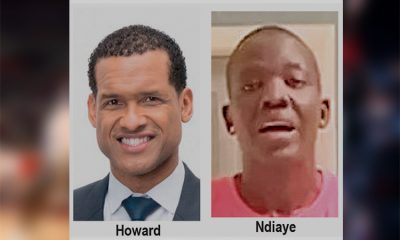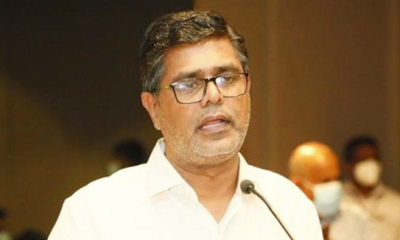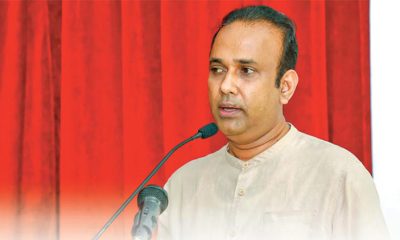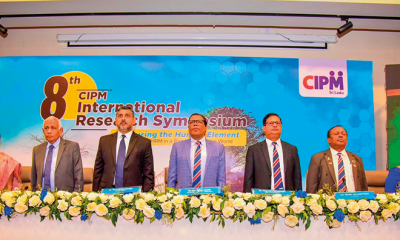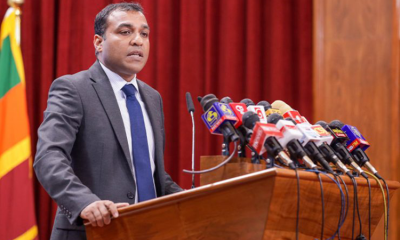Features
Forthcoming general election and its aftermath

by Neville Ladduwahetty
Sri Lankans would be going to the polls on August fifth to elect a new parliament. However, what is to follow depends on which party secures the majority to form a stable government. The prevailing prediction is that the Sri Lanka Podujana Peramuna (SLPP) is most likely to secure at least a sufficient majority to form a government.
Such an outcome would mean that President Gotabaya Rajapaksa as the Executive and a legislature headed by Prime Minister Mahinda Rajapaksa would be jointly responsible for the governance of Sri Lanka. If the SLPP secures only a simple majority the processes of governance would be constrained by the limitations and contradictions inherent in the 1978 Constitution and in the Nineteenth Amendment (19A). This would hamper post COVID-19 recovery. Therefore, it is imperative that without a two-thirds (2/3) majority to amend 1978 Constitution and 19A to bring clarity to its provisions or even introduce a new Constitution, it would not be possible for Sri Lanka to emerge from the unprecedented challenges presented by the COVID-19 disaster.
If, on the other hand, the SLPP secures only a simple majority, a national government with a 2/3 majority could be formed by means of provisions of Article 46 (4) similar to the dubious precedent crafted by the Yahapalana government. Such an approach would compel a SLPP government to accommodate the interests of coalition partners at considerable cost both financially as well as having to compromise its agenda. Therefore, if Sri Lanka is to recover from the COVID-19 crisis it is best that the government has a 2/3 majority sufficient to give it the freedom to act free of constraints of coalition demands and fetters of the 1978 Constitution and19 A.
THE NEED to REVISITING 19A
The need to revisit the 1978 Constitution and 19A is because the ambiguities and contradictions in their provisions have caused constitutional experts and academics to arrive at vastly divergent interpretations and conclusions. For instance, some interpret that 19A has transformed what was essentially a Presidential system based on separation of power into a Parliamentary system where separation of power is blurred to such an extent that they describe the present system as a Parliamentary Democracy. Others on the other hand, maintain that what 19A achieved was to prevent arbitrariness of Executive action that had existed under the 1978 Constitution, and not to transfer power from the Executive to Parliament. This is confirmed by the Supreme Court ruling on 19A that stated: “that the transfer, relinquishment or removal of a power attributed to one organ of government to another organ or body would be inconsistent with Article 3 read with Article 4 of the Constitution”. Therefore, it could be concluded that the intended transformation from a Presidential system to a Parliamentary system did not materialize notwithstanding such claims.
The 1972 Constitution is unambiguously based on a Parliamentary system while the 1978 Constitution is based on a Presidential system. However, the incorporation of certain provisions from the 1972 Constitution into to the 1978 Constitution, followed by 19A, has caused divergent interpretations. Hence, a few key issues are presented below to illustrate the need to revisit the 1978 Constitution and 19A in order to bring clarity to the current Constitutional provisions to ensure that the system of governance is either clearly Parliamentary or Presidential and not a mix of both.
CONSTITUTIONAL PROVISIONS of the 1972 CONSTITUTION
The relevant Articles in the 1972 Constitution are:
Article 91: “The President shall be responsible to the National State Assembly (Parliament) for the execution and performances of the powers and functions of his office under the Constitution…”.
Article 92 (1) states: “There shall be a Cabinet of Ministers charged with the direction and control of the government of the Republic which shall be collectively responsible to the National State Assembly and answerable to the National State Assembly on all matters for which they are responsible”.
Article 92 (2) states: “Of the Ministers, one who shall be the Head of the Cabinet of Ministers shall be the Prime Minister”.
Article 94 (1) states: “The Prime Minister shall determine the number of Ministers and Ministries and the assignment of subjects and functions to Ministers”.
Article 94 (2) states: “The President shall appoint from among the members of the National State Assembly Ministers to be in charge of the Ministries so determined”.
Article 94 (3): “The Prime Minister may at any time change the assignment of subjects and functions and recommend to the President changes to the composition of the Cabinet of Ministers…”.
CONSTITUTIONAL PROVISIONS of the 1978 CONSTITUTION
Article 42 states: “The President shall be responsible to Parliament for the due exercise, performance and discharge of the powers, duties and functions under the Constitution…’.
Article 43 (1) states: “There shall be a Cabinet of Ministers charged with the direction and control of the Government of the Republic which shall be collectively responsible and answerable to Parliament”.
Article 43 (2) states: “The President shall be a member of the Cabinet of ministers and shall be the Head of the Cabinet of Ministers”.
Article 44 (1) states: “The President from time to time, in consultation with the Prime Minister, where he considers such consultation to be necessary –
(a) “determine the number of Ministers of the Cabinet of Ministers and the Ministries and the assignment of subjects and functions to such Ministers” and
(b) “appoint from among the members of Parliament Ministers to be in charge of the Ministries so determined”.
Article 44 (3) states: “The President may at any time, change the assignment of subjects and functions and the composition of the Cabinet of Ministers…”.
CONSTITUTIONAL PROVISIONS of 19A
Article 42 (1) states: “There shall be a Cabinet of Ministers charged with the direction and control of the Government of the Republic”.
Article 42 (2) states: “The Cabinet of Ministers shall be collectively responsible and answerable to Parliament”.
Article 43 (1) states: “The President shall in consultation with the Prime Minister, where he considers such consultation to be necessary, determine the number of Ministers of the Cabinet of ministers and the Ministries and the assignment of subjects and functions to such Ministers”.
Article 43 (2) states: “The President shall on the advice of the Prime Minister appoint from among Members of Parliament, Ministers, to be in charge of the Ministries so determined”.
Article 43 (3) states: “The President may at any time change the assignment of subjects and functions and the composition of the Cabinet of Ministers…”.
IMPACT of CONTRADICTORY PROVISIONS
The constitutional provisions of the 1972 Constitution presented above are consistent with a Parliamentary system. Notwithstanding this fact, such provisions that are appropriate for a Parliamentary system have been incorporated into the 1978 Constitution and 19A that are essentially Presidential. This has caused both the 1978 Constitution and 19A to be seriously compromised. It is therefore imperative that amendments are introduced to ensure that the system of governance is either Parliamentary or Presidential in all respects.
For instance, commenting on Article 43 of the 1978 Constitution (presented above), the Supreme Court in S.D. No. 04/2015 stated: “This important Article underscores that the Cabinet collectively is charged with the exercise of Executive power, which is expressed as the direction and control of the Government of the Republic and the collective responsibility of Cabinet of which the President is the Head. It establishes conclusively that the President is not the sole repository of Executive power under the Constitution. It is the Cabinet of Ministers collectively, and not the President alone, which is charged with the direction and control of the Government. This Cabinet is answerable to Parliament. Therefore, the Constitution itself recognizes that Executive power is exercised by the President and by the Cabinet of Ministers, and that the President shall be responsible to Parliament and the Cabinet of Ministers, collectively responsible and answerable to Parliament with regard to the exercise of such powers…”.
On the other hand, the Courts have accepted that Article 3 that deals with the sovereignty of the People should be read with Article 4. Therefore, the guiding principle in the exercise of Executive power in the 1978 Constitution should be Article 4 (b). Article 4 (b) states: “the executive power of the People, including the defence of Sri Lanka, shall be exercised by the President of the Republic elected by the People”. This Article specifically reposes Executive power of the People ONLY in the President. Therefore, Executive power must necessarily be exercised solely by the President and not jointly shared with the Cabinet of Ministers. This means that anyone else exercising executive power must derive its authority from the President.
The comments of the Supreme Court in S.D. No. 04/2015 also stated: “It is in this background that the Court in the Nineteenth Amendment Determination came to a conclusion that the transfer, relinquishment or removal of the power attributed to one organ of government to another organ or body would be inconsistent with Article 3 read with Article 4 of the Constitution. Though Article 4 provides the form and manner of the sovereignty of the people, the ultimate act or decision of the executive functions must be retained by the President. So long as the President remains the Head of the Executive, the exercise of his powers remain supreme or sovereign in the executive field and to others to whom such power is given must derive the authority from the President or exercise the Executive power vested in the President as a delegate of the President”.
If, as stated above by the Court, the President as the Head of the Executive is “sovereign in the executive field”, the President who represents one of the three branches of the Government – the Executive, is co-equal with the Legislature and the Judiciary under provisions of separation of power. Therefore, the President cannot be responsible to another organ of government – the Parliament. Furthermore, since the Cabinet of Ministers derive their authority from the President, the Cabinet cannot be responsible and answerable to Parliament either. Under the circumstances, Article 33A that calls for the President to be responsible to Parliament “for the due exercise performance and discharge of his powers, duties and functions” is a violation of the principle of separation of power.
Another important issue that arises from the fact that the President is sovereign in the executive field is the constitutional provision that his executive powers include the defence of Sri Lanka. Therefore, the President has a right granted by the Constitution to be the Minister of Defence regardless of whether the President is a Member of Parliament or not. The prerogative of such a decision should be left to the President, instead of having to delegate it to someone else, invariably less competent in issues relating to security. Since the provision to select Cabinet Members from among members of Parliament is a carry-over from the defunct 1972 Constitution this constraint should be repealed since it has no relevance in a Presidential system.
ARTICLE 46 – UNIQUE ONLY TO 19A.
Article 46 (1) (a) and (b) limits the number of Cabinet of Ministers to thirty and sets an aggregate limit of forty on the number of Ministers who are not members of the Cabinet of Ministers and Deputy Ministers.
Having sets limits, the framers of 19A provided a device by means of Article 46 (4) and (5) to enable Parliament by Resolution to exceed the very limits they themselves stipulated above. In fact, this device is so crafty that it enables even a minority government with the largest majority to form a National Government with even a 2/3 majority by forming a coalition with other recognized political parties. Had the Article stated “the political party with the largest majority together with ALL other political parties” the task of forming a National Government would in all likelihood been unrealistic. This device was exploited to the fullest advantage by the former Yahapalana government. The net effect of the current provisions in 19A is to ridicule their own attempts to appear well intentioned by proposing a leaner Cabinet and make a mockery of the “will of the people” by introducing a corrupted way out of the limits set by themselves.
19A – THE CONSTITUTIONAL COUNCIL
Article 41 B (1) states: “No person shall be appointed by the President as the Chairman or the member of any of the Commissions specified in the Schedule to this Article, except on a recommendation of the Council”.
Article 41 C (1) states: “No person shall be appointed by the President to any of the Officers specified in the Schedule to this Article…unless such appointment has been approved by the Council”.
The Court ruled that the transfer, relinquishment or removal of power attributed to one organ to another violates Article 3 when read with Article 4 of the Constitution. If this is so, would not the transfer of power that the President had, to appoint Commissions and Officers prior to 19A, to another body that is not even another organ of Government as recognized by Article 3 read with Article 4, amount to a violation of the sovereignty of the People? Furthermore, the operation of the Council has become so dysfunctional that the country today does not have a functioning Inspector General of Police. The reason for this is a system failure because the President who makes the appointment could keep on rejecting nominations by the Council causing posts being vacant as in the case of the IGP. Therefore, this provision too needs to be seriously amended. An alternative would be to restore the powers the President had under Articles 54, 55 and 107 of the 1978 Constitution and for him to make appointments subject to the approval of the appropriate Oversight Committees of Parliament and repeal Chapter VIIA of 19A.
19A – DISSOLUTION of PARLIAMENT
According to 19A Article 70 (1) states: “The President may by Proclamation, summon, prorogue and dissolve Parliament. Provided that the President shall not dissolve until the expiration of a period of not less than four years and six months…unless Parliament requests the President to do so by a resolution passed by not less than two-third of the whole number of Members voting in favour”.
This Article presents two serious issues. One, it places the President at a disadvantage in relation to Parliament since Parliament is not constrained by a time bar whereas the President is. Therefore, Parliament could request the President to dissolve Parliament at any time with a 2/3 majority whereas the President is compelled to wait four and half years to dissolve Parliament. Such drastic disadvantages are not in keeping with principles of separation of power among co-equals. Such inequality is unacceptable for two separate organs of government elected separately by the People. The second serious issue is that securing a 2/3 majority for a political party under provisions of proportional representation is bound to be a rarity. This compels Parliament to continue however dysfunctional it is.
Therefore, the net effect of Article 70 (1) as currently presented is for the country to be governed by a government even if the situation is so dire that it warrants dissolution of Parliament because of the constitutional straightjacket of this Article. Consequently, as always, it is the People who have to endure.
CONCLUSION
The outcome of the forthcoming General Election to elect a new Parliament would have a serious impact on how effectively Sri Lanka recovers from the challenges imposed by the unprecedented COVID -19 crisis. The most significant single factor that would influence the recovery process is the current Constitution. The 1978 Constitution and 19A contain constitutional provisions that are a mix appropriate to both Parliamentary and Presidential systems. This has made governing processes convoluted. Therefore, it is imperative that the current provisions are amended, so that the Constitution is Presidential in all respects and not a mix of both Parliamentary and Presidential as currently exists, with the appropriate checks and balances by the Parliament and the Judiciary, in a way that would not hamper effective Executive action.
The reason for the existence of Parliamentary and Presidential systems in the present Constitution is because the operation of a Presidential system based on separation of power, is not commonly understood despite it being in existence for over four decades. A glaring example of the lack of appreciation of what separation of power means is selection of the Cabinet of Ministers from among Members of Parliament. This results in the same individual serving two separate organs of government resulting in conflict of interest. This practice should cease. If Members of Parliament are to be Members of the Cabinet, they should relinquish their association with Parliament as practiced by other countries with Presidential systems.
Under the circumstances, a government with a simple majority would not be in a position to introduce the needed amendments without which the recovery process would be hampered by the existing constitutional ambiguities and contradictions. Therefore, it is only a 2/3 Parliamentary majority that would facilitate the introduction of the needed amendments without which it would not be possible for Sri Lanka to emerge from the unprecedented challenges presented by COVID-19 pandemic.
Features
The heart-friendly health minister

by Dr Gotabhya Ranasinghe
Senior Consultant Cardiologist
National Hospital Sri Lanka
When we sought a meeting with Hon Dr. Ramesh Pathirana, Minister of Health, he graciously cleared his busy schedule to accommodate us. Renowned for his attentive listening and deep understanding, Minister Pathirana is dedicated to advancing the health sector. His openness and transparency exemplify the qualities of an exemplary politician and minister.
Dr. Palitha Mahipala, the current Health Secretary, demonstrates both commendable enthusiasm and unwavering support. This combination of attributes makes him a highly compatible colleague for the esteemed Minister of Health.
Our discussion centered on a project that has been in the works for the past 30 years, one that no other minister had managed to advance.
Minister Pathirana, however, recognized the project’s significance and its potential to revolutionize care for heart patients.
The project involves the construction of a state-of-the-art facility at the premises of the National Hospital Colombo. The project’s location within the premises of the National Hospital underscores its importance and relevance to the healthcare infrastructure of the nation.
This facility will include a cardiology building and a tertiary care center, equipped with the latest technology to handle and treat all types of heart-related conditions and surgeries.
Securing funding was a major milestone for this initiative. Minister Pathirana successfully obtained approval for a $40 billion loan from the Asian Development Bank. With the funding in place, the foundation stone is scheduled to be laid in September this year, and construction will begin in January 2025.
This project guarantees a consistent and uninterrupted supply of stents and related medications for heart patients. As a result, patients will have timely access to essential medical supplies during their treatment and recovery. By securing these critical resources, the project aims to enhance patient outcomes, minimize treatment delays, and maintain the highest standards of cardiac care.
Upon its fruition, this monumental building will serve as a beacon of hope and healing, symbolizing the unwavering dedication to improving patient outcomes and fostering a healthier society.We anticipate a future marked by significant progress and positive outcomes in Sri Lanka’s cardiovascular treatment landscape within the foreseeable timeframe.
Features
A LOVING TRIBUTE TO JESUIT FR. ALOYSIUS PIERIS ON HIS 90th BIRTHDAY

by Fr. Emmanuel Fernando, OMI
Jesuit Fr. Aloysius Pieris (affectionately called Fr. Aloy) celebrated his 90th birthday on April 9, 2024 and I, as the editor of our Oblate Journal, THE MISSIONARY OBLATE had gone to press by that time. Immediately I decided to publish an article, appreciating the untiring selfless services he continues to offer for inter-Faith dialogue, the renewal of the Catholic Church, his concern for the poor and the suffering Sri Lankan masses and to me, the present writer.
It was in 1988, when I was appointed Director of the Oblate Scholastics at Ampitiya by the then Oblate Provincial Fr. Anselm Silva, that I came to know Fr. Aloy more closely. Knowing well his expertise in matters spiritual, theological, Indological and pastoral, and with the collaborative spirit of my companion-formators, our Oblate Scholastics were sent to Tulana, the Research and Encounter Centre, Kelaniya, of which he is the Founder-Director, for ‘exposure-programmes’ on matters spiritual, biblical, theological and pastoral. Some of these dimensions according to my view and that of my companion-formators, were not available at the National Seminary, Ampitiya.
Ever since that time, our Oblate formators/ accompaniers at the Oblate Scholasticate, Ampitiya , have continued to send our Oblate Scholastics to Tulana Centre for deepening their insights and convictions regarding matters needed to serve the people in today’s context. Fr. Aloy also had tried very enthusiastically with the Oblate team headed by Frs. Oswald Firth and Clement Waidyasekara to begin a Theologate, directed by the Religious Congregations in Sri Lanka, for the contextual formation/ accompaniment of their members. It should very well be a desired goal of the Leaders / Provincials of the Religious Congregations.
Besides being a formator/accompanier at the Oblate Scholasticate, I was entrusted also with the task of editing and publishing our Oblate journal, ‘The Missionary Oblate’. To maintain the quality of the journal I continue to depend on Fr. Aloy for his thought-provoking and stimulating articles on Biblical Spirituality, Biblical Theology and Ecclesiology. I am very grateful to him for his generous assistance. Of late, his writings on renewal of the Church, initiated by Pope St. John XX111 and continued by Pope Francis through the Synodal path, published in our Oblate journal, enable our readers to focus their attention also on the needed renewal in the Catholic Church in Sri Lanka. Fr. Aloy appreciated very much the Synodal path adopted by the Jesuit Pope Francis for the renewal of the Church, rooted very much on prayerful discernment. In my Religious and presbyteral life, Fr.Aloy continues to be my spiritual animator / guide and ongoing formator / acccompanier.
Fr. Aloysius Pieris, BA Hons (Lond), LPh (SHC, India), STL (PFT, Naples), PhD (SLU/VC), ThD (Tilburg), D.Ltt (KU), has been one of the eminent Asian theologians well recognized internationally and one who has lectured and held visiting chairs in many universities both in the West and in the East. Many members of Religious Congregations from Asian countries have benefited from his lectures and guidance in the East Asian Pastoral Institute (EAPI) in Manila, Philippines. He had been a Theologian consulted by the Federation of Asian Bishops’ Conferences for many years. During his professorship at the Gregorian University in Rome, he was called to be a member of a special group of advisers on other religions consulted by Pope Paul VI.
Fr. Aloy is the author of more than 30 books and well over 500 Research Papers. Some of his books and articles have been translated and published in several countries. Among those books, one can find the following: 1) The Genesis of an Asian Theology of Liberation (An Autobiographical Excursus on the Art of Theologising in Asia, 2) An Asian Theology of Liberation, 3) Providential Timeliness of Vatican 11 (a long-overdue halt to a scandalous millennium, 4) Give Vatican 11 a chance, 5) Leadership in the Church, 6) Relishing our faith in working for justice (Themes for study and discussion), 7) A Message meant mainly, not exclusively for Jesuits (Background information necessary for helping Francis renew the Church), 8) Lent in Lanka (Reflections and Resolutions, 9) Love meets wisdom (A Christian Experience of Buddhism, 10) Fire and Water 11) God’s Reign for God’s poor, 12) Our Unhiddden Agenda (How we Jesuits work, pray and form our men). He is also the Editor of two journals, Vagdevi, Journal of Religious Reflection and Dialogue, New Series.
Fr. Aloy has a BA in Pali and Sanskrit from the University of London and a Ph.D in Buddhist Philosophy from the University of Sri Lankan, Vidyodaya Campus. On Nov. 23, 2019, he was awarded the prestigious honorary Doctorate of Literature (D.Litt) by the Chancellor of the University of Kelaniya, the Most Venerable Welamitiyawe Dharmakirthi Sri Kusala Dhamma Thera.
Fr. Aloy continues to be a promoter of Gospel values and virtues. Justice as a constitutive dimension of love and social concern for the downtrodden masses are very much noted in his life and work. He had very much appreciated the commitment of the late Fr. Joseph (Joe) Fernando, the National Director of the Social and Economic Centre (SEDEC) for the poor.
In Sri Lanka, a few religious Congregations – the Good Shepherd Sisters, the Christian Brothers, the Marist Brothers and the Oblates – have invited him to animate their members especially during their Provincial Congresses, Chapters and International Conferences. The mainline Christian Churches also have sought his advice and followed his seminars. I, for one, regret very much, that the Sri Lankan authorities of the Catholic Church –today’s Hierarchy—- have not sought Fr.
Aloy’s expertise for the renewal of the Catholic Church in Sri Lanka and thus have not benefited from the immense store of wisdom and insight that he can offer to our local Church while the Sri Lankan bishops who governed the Catholic church in the immediate aftermath of the Second Vatican Council (Edmund Fernando OMI, Anthony de Saram, Leo Nanayakkara OSB, Frank Marcus Fernando, Paul Perera,) visited him and consulted him on many matters. Among the Tamil Bishops, Bishop Rayappu Joseph was keeping close contact with him and Bishop J. Deogupillai hosted him and his team visiting him after the horrible Black July massacre of Tamils.
Features
A fairy tale, success or debacle

Sri Lanka-Singapore Free Trade Agreement
By Gomi Senadhira
senadhiragomi@gmail.com
“You might tell fairy tales, but the progress of a country cannot be achieved through such narratives. A country cannot be developed by making false promises. The country moved backward because of the electoral promises made by political parties throughout time. We have witnessed that the ultimate result of this is the country becoming bankrupt. Unfortunately, many segments of the population have not come to realize this yet.” – President Ranil Wickremesinghe, 2024 Budget speech
Any Sri Lankan would agree with the above words of President Wickremesinghe on the false promises our politicians and officials make and the fairy tales they narrate which bankrupted this country. So, to understand this, let’s look at one such fairy tale with lots of false promises; Ranil Wickremesinghe’s greatest achievement in the area of international trade and investment promotion during the Yahapalana period, Sri Lanka-Singapore Free Trade Agreement (SLSFTA).
It is appropriate and timely to do it now as Finance Minister Wickremesinghe has just presented to parliament a bill on the National Policy on Economic Transformation which includes the establishment of an Office for International Trade and the Sri Lanka Institute of Economics and International Trade.
Was SLSFTA a “Cleverly negotiated Free Trade Agreement” as stated by the (former) Minister of Development Strategies and International Trade Malik Samarawickrama during the Parliamentary Debate on the SLSFTA in July 2018, or a colossal blunder covered up with lies, false promises, and fairy tales? After SLSFTA was signed there were a number of fairy tales published on this agreement by the Ministry of Development Strategies and International, Institute of Policy Studies, and others.
However, for this article, I would like to limit my comments to the speech by Minister Samarawickrama during the Parliamentary Debate, and the two most important areas in the agreement which were covered up with lies, fairy tales, and false promises, namely: revenue loss for Sri Lanka and Investment from Singapore. On the other important area, “Waste products dumping” I do not want to comment here as I have written extensively on the issue.
1. The revenue loss
During the Parliamentary Debate in July 2018, Minister Samarawickrama stated “…. let me reiterate that this FTA with Singapore has been very cleverly negotiated by us…. The liberalisation programme under this FTA has been carefully designed to have the least impact on domestic industry and revenue collection. We have included all revenue sensitive items in the negative list of items which will not be subject to removal of tariff. Therefore, 97.8% revenue from Customs duty is protected. Our tariff liberalisation will take place over a period of 12-15 years! In fact, the revenue earned through tariffs on goods imported from Singapore last year was Rs. 35 billion.
The revenue loss for over the next 15 years due to the FTA is only Rs. 733 million– which when annualised, on average, is just Rs. 51 million. That is just 0.14% per year! So anyone who claims the Singapore FTA causes revenue loss to the Government cannot do basic arithmetic! Mr. Speaker, in conclusion, I call on my fellow members of this House – don’t mislead the public with baseless criticism that is not grounded in facts. Don’t look at petty politics and use these issues for your own political survival.”
I was surprised to read the minister’s speech because an article published in January 2018 in “The Straits Times“, based on information released by the Singaporean Negotiators stated, “…. With the FTA, tariff savings for Singapore exports are estimated to hit $10 million annually“.
As the annual tariff savings (that is the revenue loss for Sri Lanka) calculated by the Singaporean Negotiators, Singaporean $ 10 million (Sri Lankan rupees 1,200 million in 2018) was way above the rupees’ 733 million revenue loss for 15 years estimated by the Sri Lankan negotiators, it was clear to any observer that one of the parties to the agreement had not done the basic arithmetic!
Six years later, according to a report published by “The Morning” newspaper, speaking at the Committee on Public Finance (COPF) on 7th May 2024, Mr Samarawickrama’s chief trade negotiator K.J. Weerasinghehad had admitted “…. that forecasted revenue loss for the Government of Sri Lanka through the Singapore FTA is Rs. 450 million in 2023 and Rs. 1.3 billion in 2024.”
If these numbers are correct, as tariff liberalisation under the SLSFTA has just started, we will pass Rs 2 billion very soon. Then, the question is how Sri Lanka’s trade negotiators made such a colossal blunder. Didn’t they do their basic arithmetic? If they didn’t know how to do basic arithmetic they should have at least done their basic readings. For example, the headline of the article published in The Straits Times in January 2018 was “Singapore, Sri Lanka sign FTA, annual savings of $10m expected”.
Anyway, as Sri Lanka’s chief negotiator reiterated at the COPF meeting that “…. since 99% of the tariffs in Singapore have zero rates of duty, Sri Lanka has agreed on 80% tariff liberalisation over a period of 15 years while expecting Singapore investments to address the imbalance in trade,” let’s turn towards investment.
Investment from Singapore
In July 2018, speaking during the Parliamentary Debate on the FTA this is what Minister Malik Samarawickrama stated on investment from Singapore, “Already, thanks to this FTA, in just the past two-and-a-half months since the agreement came into effect we have received a proposal from Singapore for investment amounting to $ 14.8 billion in an oil refinery for export of petroleum products. In addition, we have proposals for a steel manufacturing plant for exports ($ 1 billion investment), flour milling plant ($ 50 million), sugar refinery ($ 200 million). This adds up to more than $ 16.05 billion in the pipeline on these projects alone.
And all of these projects will create thousands of more jobs for our people. In principle approval has already been granted by the BOI and the investors are awaiting the release of land the environmental approvals to commence the project.
I request the Opposition and those with vested interests to change their narrow-minded thinking and join us to develop our country. We must always look at what is best for the whole community, not just the few who may oppose. We owe it to our people to courageously take decisions that will change their lives for the better.”
According to the media report I quoted earlier, speaking at the Committee on Public Finance (COPF) Chief Negotiator Weerasinghe has admitted that Sri Lanka was not happy with overall Singapore investments that have come in the past few years in return for the trade liberalisation under the Singapore-Sri Lanka Free Trade Agreement. He has added that between 2021 and 2023 the total investment from Singapore had been around $162 million!
What happened to those projects worth $16 billion negotiated, thanks to the SLSFTA, in just the two-and-a-half months after the agreement came into effect and approved by the BOI? I do not know about the steel manufacturing plant for exports ($ 1 billion investment), flour milling plant ($ 50 million) and sugar refinery ($ 200 million).
However, story of the multibillion-dollar investment in the Petroleum Refinery unfolded in a manner that would qualify it as the best fairy tale with false promises presented by our politicians and the officials, prior to 2019 elections.
Though many Sri Lankans got to know, through the media which repeatedly highlighted a plethora of issues surrounding the project and the questionable credentials of the Singaporean investor, the construction work on the Mirrijiwela Oil Refinery along with the cement factory began on the24th of March 2019 with a bang and Minister Ranil Wickremesinghe and his ministers along with the foreign and local dignitaries laid the foundation stones.
That was few months before the 2019 Presidential elections. Inaugurating the construction work Prime Minister Ranil Wickremesinghe said the projects will create thousands of job opportunities in the area and surrounding districts.
The oil refinery, which was to be built over 200 acres of land, with the capacity to refine 200,000 barrels of crude oil per day, was to generate US$7 billion of exports and create 1,500 direct and 3,000 indirect jobs. The construction of the refinery was to be completed in 44 months. Four years later, in August 2023 the Cabinet of Ministers approved the proposal presented by President Ranil Wickremesinghe to cancel the agreement with the investors of the refinery as the project has not been implemented! Can they explain to the country how much money was wasted to produce that fairy tale?
It is obvious that the President, ministers, and officials had made huge blunders and had deliberately misled the public and the parliament on the revenue loss and potential investment from SLSFTA with fairy tales and false promises.
As the president himself said, a country cannot be developed by making false promises or with fairy tales and these false promises and fairy tales had bankrupted the country. “Unfortunately, many segments of the population have not come to realize this yet”.
(The writer, a specialist and an activist on trade and development issues . )


